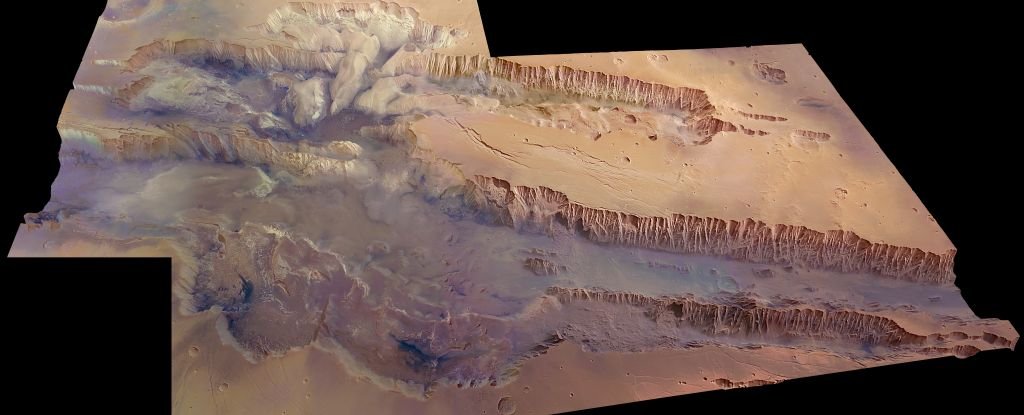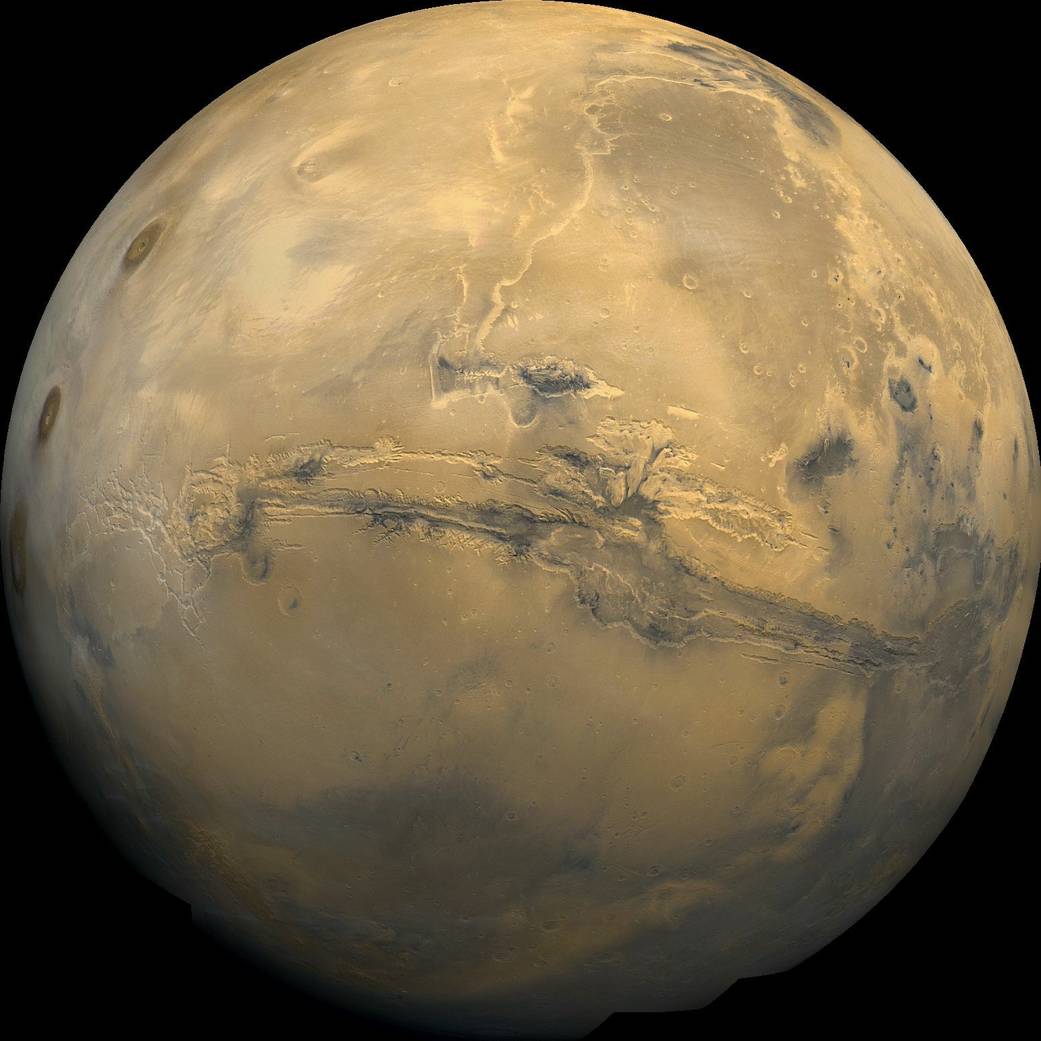
Posted on 12/16/2021 8:22:44 AM PST by Red Badger

A digital terrain model of Valles Marineris. (ESA/DLR/FU Berlin (G. Neukum), CC BY-SA 3.0 IGO)
----------------------------------------------------------------------------
A vast system of canyons that dramatically scars the face of Mars could be harboring reserves of hidden water.
An unusually high quantity of hydrogen has been detected in the heart of the 4,000 kilometers (2,485 miles) of canyons known as Valles Marineris, nicknamed the Grand Canyon of Mars. We know this thanks to new data from the ESA-Roscosmos ExoMars Trace Gas Orbiter's FREND instrument.
The finding suggests that, at depths up to a meter (three feet) below the surface, the soil in the region is rich in water, either bound up in minerals or as subsurface water ice, potentially offering a new way of locating the precious stuff on the apparently extremely arid world.
"With the Trace Gas Orbiter, we can look down to one meter below this dusty layer and see what's really going on below Mars's surface – and, crucially, locate water-rich 'oases' that couldn't be detected with previous instruments," said physicist Igor Mitrofanov of the Space Research Institute of the Russian Academy of Sciences in Russia; lead author of the new study.
"FREND revealed an area with an unusually large amount of hydrogen in the colossal Valles Marineris canyon system: Assuming the hydrogen we see is bound into water molecules, as much as 40 percent of the near-surface material in this region appears to be water."
We know there's water on Mars. We can see it, at the cold poles, bound up as ice. That's where most of it seems to be; at the equator, conditions are too warm for water ice to form at the surface.
It's possible that water can be found under the surface, but other previous searches by other Mars satellites only found it at higher latitudes.
Cue FREND, or the Fine Resolution Epithermal Neutron Detector. Rather than mapping light at the very surface of the red planet, FREND detects neutrons. This allows it to see the hydrogen content of Mars's soil up to a meter below the surface, the researchers said. Which, in observations taken between May 2018 and February 2021, it seems to have done.
"Neutrons are produced when highly energetic particles known as galactic cosmic rays strike Mars; drier soils emit more neutrons than wetter ones, and so we can deduce how much water is in a soil by looking at the neutrons it emits," said physicist Alexey Malakhov, also of the Space Research Institute of the Russian Academy of Sciences.
"We found a central part of Valles Marineris to be packed full of water – far more water than we expected. This is very much like Earth's permafrost regions, where water ice permanently persists under dry soil because of the constant low temperatures."

Viking orbiter mosaic showing Valles Marineris across the face of Mars. (NASA)
____________________________________________________________________________
The high-hydrogen region is about the size of the Netherlands, and overlaps with Candor Chasma, one of the largest canyons in the Valles Marineris system. In this region of Mars, minerals typically contain very little water, so the researchers believe the substance is likely in the form of water ice below the surface.
But how that water could persist there is a mystery. Pressure and temperature conditions at the Mars equator ought to prohibit the formation of such water reserves. There may be some unknown combination of geomorphological conditions in Valles Marineris that allows it, such as patchy isolated deposits that have been there for some time, or the angle and orientation of steep slopes.
Further investigation will be needed to work out exactly what is going on – not just the conditions that allow for equatorial water on Mars, but to confirm what form that water takes. Doing so could be deeply rewarding: stores of water in a permafrost-like form may, just as we have found right here on Earth, have preserved frozen fragments of microbial life, or organic molecules that once existed on Mars.
The discovery also represents exciting possibilities for Mars exploration. Any crewed Mars mission is likely to set down near the equator; water that might be found not far beneath the surface would be an amazing asset, both for exploration purposes, and for the vital task of keeping water-reliant humans alive.
And, of course, it makes scientists even more keen to visit the unusual and fascinating Valles Marineris – the largest canyon in our Solar System.
"This result really demonstrates the success of the joint ESA-Roscosmos ExoMars programme," said physicist Colin Wilson of the European Space Agency.
"Knowing more about how and where water exists on present-day Mars is essential to understand what happened to Mars's once-abundant water, and helps our search for habitable environments, possible signs of past life, and organic materials from Mars's earliest days."
The team's research has been published in Icarus.
PING!..................

Quaaaade. Start the reactor!
Well, it’s not secret anymore blabbermouths.
Valles Marineris. The scale is difficult to comprehend. It is as long as the continental U.S. and up to 8 miles deep, compared to the Grand Canyon at 1 mile deep.
https://www.space.com/20446-valles-marineris.html

That will be quite the tourist destination someday.
Elon will make it so.................
California is already working on how to lay claim to most of the water rights. If you say they have no rights to the water in another State or on another planet then you’re a racist homophobe.
Newsome:
I can see Mars from my house!........................
Looks like a planetary hit and run scene.


Nah, more a fender bender. Does not have the radiating lines of a direct hit.
Headline is misleading. Seems like all they could detect was hydrogen. Did they rule out metal hydrides? Or sulfuric acid, or other acids? Did they look for oxygen?
The article also mentions that there was once life on mars. Supposedly cold and wet conditions can preserve fragments of microbial life and organic molecules. Mere supposition.
How did life form in such cold conditions? Where is the warm little pond, or hydrothermal vents, or bright sunlight?
You mean to tell me that the Mars Rover doesn’t have a divining rod?
Poor planning..
You would have thought that they would at least have included a roll of Bounty Paper Towels.......................
Well, so much for secrets. Now everybody knows
Those three brown circles on the left side of the planet appear to be equidistant apart...
Disclaimer: Opinions posted on Free Republic are those of the individual posters and do not necessarily represent the opinion of Free Republic or its management. All materials posted herein are protected by copyright law and the exemption for fair use of copyrighted works.